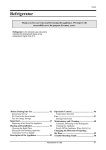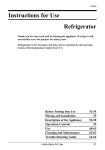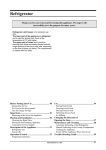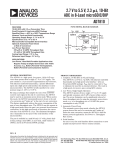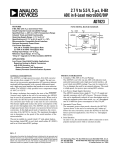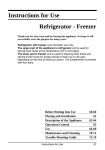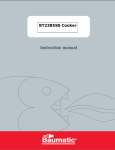Download Gorenje MK100S-R41
Transcript
Pantry kitchen EN Thank you for your trust and for buying this appliance. We hope it will successfull y serve the purpose for many years. The pantry kitchen was designed for home use and it consists of a cooker (two hot plates), a refrigerater and a sink. Before Use ....................................................... 2 Cooker Refrigerator We Care for the Environment Tips for Energy Savings ................................. 3 Refrigerator Cooker Tips for purchasing crockery Tips for effective use of crockery Description of the Appliance .......................... 6 Hot plates ......................................................... 6 Important warnings! Special warning for hotplates Operation of hotplates Extra Fast Hot Plate Control Lamp Refrigerator ..................................................... 7 Important......................................................... 4 Cooker Refrigerator Refrigerator (A) Operation Control Use Maintenance and Cleaning........................... 10 Positioning and Installation ........................... 5 Choosing the Right Place Placing Connection to Power Supply Connecting the Water Outlet Hot Plates Refrigerator Sink Trouble-Shooting Guide ............................... 12 Before Use This instruction manual has been prepared for the user of the pantry kitchen. Read the manual carefully and get to know your kitchen so that you will know how to use it safely and correctly. Instructions for Use were prepared for various types of refrigerators therefore you might find in it some functions that do not apply to your appliance and description of the accesories that your appliance does not include. We Care for the Environment Packaging Cooker Turn the hotplates on at maximum power for 3 to 5 minutes without any dishes, in order to smoke them out. This procedure aims to reinforce the protective film upon the hotplate surface. Refrigerator x Before connecting the appliance to the mains supply, let it stand for about 2 hours, which will reduce the possibility of malfunctions in the cooling system due to transport handling. 2 x Clean the appliance thoroughly, especially in the interior (See Cleaning and Maintenance). x If the interior accessories are not correctly placed, rearrange them as described in the "Description of the Appliance" section (accessories may vary according to model). x Our products use environmentally friendly packaging, which can be either recycled or disposed of in an environmentally friendly manner. To this end, individual packaging materials are clearly marked. x These instructions are printed either on recycled paper or chlorine free bleached paper. When your appliance finally wears out, please try not to burden the environment with it; call x These are mainly artificial materials like high-density polyethylene (PE-HD), low-density polyethylene (PE-LD), polypropylene (PP) and Instructions for Use polystyrol (PS), as well as paper, cardboard and other similar materials. The symbol on the product or on its packaging indicates that this product may not be treated as household waste. Instead it shall be handed over to the applicable collection point for the recycling of electrical and electronic equipment. By ensuring this product is disposed of correctly, you will help prevent potential negative consequences for the environment and human health, which could otherwise be caused by inappropriate waste handling of this product. For more detailed information about recycling of this product, please contact your local city office, your household waste disposal service or the shop where you purchased the product. Tips for Energy Savings By using the appliance correctly and by taking into account our recommendations, you can make substantial energy savings. Refrigerator x Try not to open the door too often, especially when the weather is wet and hot. Once you open the door, remember to close it as soon as possible. x Every now and then check if the appliance is suffIciently ventilated (adequate air circulation behind the appliance). x Set the thermostat from higher to lower settings as soon as possible (depends on how loaded the appliance is, ambient temperature etc). x Before loading the appliance with packages of fresh foods, make sure they are cooled to ambient temperature. x Ice and frost layers increase energy consumption, so do clean the appliance as soon as the layer is 3 - 5 mm thick. x The condenser on the rear wall should be always clean, free of dust or any impurities. Cooker The dish is too big or too small. Temperature resistant glass, protruding over the edge, might break. Dish with too small bottom diameter excessively consumes energy and is not economical. incorrect Adequate size of cooking dishes. Below are some important suggestions how to use your new cooker and its accessories in order to save as much energy as possible. correct Stick to the general rule: The better the quality of the dish, the lower consumption of energy! Tips for purchasing crockery The bottom of the dish is too thin and becomes crooked in the process of heating up. The consequence is excessive consumption of energy and uneven distribution of heat. incorrect x Good quality dishes feature thick flat bottom. Uneven bottom of the dish causes increased consumption of energy and extended cooking time. x When purchasing new crockery carefully check if the diameter quoted refers to the upper rim or the bottom. The latter is usually always smaller. x Use of pressure cookers additionally saves energy, since food is prepared in a closed dish and under pressure. Furthermore, shorter cooking time preserves the vitamin contents. Instructions for Use 3 Tips for effective use of crockery x The best transfer of energy is obtained if the bottom diameter of the dish is identical to the hotplate diameter, and if the dish is placed exactly in the center of the hotplate. x If the diameter differs, it is always better to have bigger crockery than smaller. The loss of energy is greater, and stains may be burned to the hotplate. x Use pot lids and cover your cookware whenever possible. x The dish size should always suit the quantity of food. Excessively big pot wastes too much energy. x Reduce power regulation towards the end of cooking, and switch the hotplate off before cooking is complete, to be able to use the remaining heat. x Always provide adequate quantity of water when cooking in the pressure cooker. Lack of water may cause damage to the dish and to the hotplate. x Temperature resistant glass cookware is suitable for use with the hotplate if the bottom diameter of such dish is adequate to the diameter of the hotplate. Dish protruding over the hotplate edge may break as a consequence of created thermal tension. x When using special cookware, always follow the manufacturer's instructions. Important x The cooker and the refrigerator should be professionally connected to the mains. Leave any further repairs to an expert as well. x Rating plate is located on the inner side of the multi-purpose section. x The appliance is manufactured in compliance with all relevant safety standards; however, it is recommended that persons with impaired physical, motional, or mental abilities, or persons with inadequate experience and knowledge, do not use the appliance without due supervision. The same recommendation applies to minors using the appliance. x Children should be supervised to ensure that they do not play with appliance. x The appliance is not intended to be operated by means of external timer or separate remotecontrol system. Cooker x Any repairs by unqualified persons may result in electric shock or short circuit. In order to avoid possible injuries to your body or to the appliance, do not attempt any repairs by yourself. Such work should be carried out by qualified service personnel. x Hot grease is highly inflammable, so pay extra attention when preparing food with grease or oil. Frying may be carried out only under constant surveillance. x Warning: do not let small children in the vicinity of the cooker; they are not yet aware of danger of burns. Older children may use the appliance only under your surveillance. x Danger of burns: hotplates and cooking accessories may become very hot during 4 operation. To avoid burns use kitchen clothes and gloves when handling hot parts or utensils. x Mains lead of adjacent appliances may be damaged by hotplates and produce short circuit, therefore keep them at safe distance from the appliance. x This appliance is intended for use in your household. Never use the appliance for any other purpose! Refrigerator x If you have an old appliance at home which can no longer be used and which is equipped with a lock that cannot be opened from the inside (lock, bolt), make sure that the lock is broken. This will make it impossible for children to lock themselves inside the appliance and suffocate. x Do not touch the cooled surfaces while the appliance is operating, especially not with wet hands - the skin may stick to the cold surfaces. x Do not freeze bottles containing liquid, especially not soft drinks, such as mineral water, sparkling wine, beer, Cola etc. - liquid expands during freezing and glass bottles are very likely to blow up. x Do not eat frozen food (bread, fruit, vegetables) - you can get frostbite. x If the food has a strange smell or colour, throw it away - it is very likely that it is spoiled and therefore dangerous to eat. x Disconnect the appliance from the power supply before repairing it (only a qualified technician should repair it), before cleaning and before replacing the light bulb. x Do not defrost the appliance with other electric devices (hair dryer etc.), and never scrape off the ice or frost layer with sharp tools. Instructions for Use x For the sake of environment protection - be careful not to damage the rear wall of the appliance (the condenser unit or the tubes - for example when moving the appliance) or any part of the refrigerating system inside the appliance. Do not use sharp object for defrosting the appliance. Use only enclosed tools or tools recommended by the manufacturer. x The refrigerating system of the appliance is filled with refrigerant and oil, so when the appliance is damaged, handle it with care and dispose it of in compliance with environmental protecting precautions. x In the supply cord is damaged, it must be replaced by the manufacturer or his service agent or a qualified person in order to avoid hazard. x The rating plate is inside the appliance or outside on the rear wall. Positioning and Installation Choosing the Right Place Connection to Power Supply Place the Pantry kitchen in a dry and regularly Allowed ambient temperature depends on the model (class) of the appliance and is stated on the rating plate of the appliance. Do not place the unit near heat-emitting devices (e.g. cooker, radiator, water heater or similar devices), and do not expose it to direct sunlight. Class SN (sub-normal) N (normal) ST (sub-tropical) T (tropical) Ambient temperature od + 10°C do + 32°C od + 16°C do + 32°C od + 16°C do + 38°C od + 16°C do + 43°C Placing x Place the unit firmly on a solid base. x On the front side of the appliance, there are three adjustable feet; two of them are used for leveling the refrigerator, while the third is used for leveling the whole unit. x For fire protection, this pantry kitchen complies with the Y class, which means that other kitchen units can be located on both sides of the unit; one of them should be the same height as the unit, the other can be higher. x Warning! The appliance should not be installed in a built-in element or cupboard. Plug the cooktop and the refrigerator power lead to the mains supply. The power lead must be fitted with earthing pin (safety socket). The standard nominal voltage and frequency are indicated at rating plate(s) of the cooktop and the fridge. The connection to the mains supply and earthing have to be made according to current standards and regulations. The refrigerator resists temporary voltage tolerance between -6 and +6 %. If there is no power supply cord provided in the pantry kitchen, a special device for separation of all poles from the mains supply must be included when permanently installing the appliance, with a minimum distance of 3 mm between the contacts in the open position. To replace a damaged power supply cord a special device must be used therefore a serviceman authorised by the producer must be called. Connecting the Water Outlet Mount the sink to the water outlet according to current regulations. Leave the work to an expert who can at the same time check whether the sink is watertight or not. Instructions for Use 5 Description of the Appliance The cooker of the kitchen unit is located above the refrigerator. Under the sink, there is an empty space which can be used for storing various household accessories or for mounting the waste bin. The pantry kitchen with control knobs located by the hot plates is manufactured in two versions - right-handed and left-handed. Both versions may incorporate one of the following type of refrigerator: HTS 1351, HTS 1356. , 1 - Control lamp 2 - Control knobs for hot plates 3 - Hot plate 4 - Refrigerator 5 - Sink 6 - Multi-purpose space 7 - Leveling feet Hot plates Control knobs can be either on the top, beside the hot plates. Knobs are marked from 1 to 3 for heating power. Position 1 is the lowest heating power, position 3 is the highest heating power and in position 0 the hot plate is switched off. Intermediate settings are also marked and are set discontinuously (in stages). Important warnings! x Never switch on empty hotplates, without dishes, and never use hotplates for heating the ambience! 6 x Keep the hotplates and the cookware clean, because dirt may affect your cooking results. x Hot oil or grease is highly inflammable, so the preparation of food with large quantities of oil (chips) should be under constant surveillance at all times. Special warning for hotplates x Never place wet dishes or steaming lids upon the hotplate. Humidity may damage hotplates. x Never cool down hot dishes upon idle hotplates, because condensation below the dish may cause corrosion of the hotplate. Instructions for Use Operation of hotplates x Hotplates are controlled by knobs, located at the control panel. x Symbols adjacent to the knobs indicate their location. x Heating power is regulated in steps. (0-3). x It is recommended to switch the hotplate off 3-5 minutes before the completion of cooking, and use the remaining accumulated heat. x Following are the recommended power regulations. Step S 0 x 1 x 2 x 3 Suitable for hotplate off, use of remaining heat maintaining temperature, slow cooking, small quantities of food (min. power) slow cooking slow cooking of large quantities, slow fryanig of large big chunks frying, preparing soup basis frying boiling, browning, frying (maximum power) Extra Fast Hot Plate Express hotplate is more powerful than the regular one, which means that it heats up much quicker. It is marked by the red dot in the middle,which may disappear with time due to repeated cleaning. Control Lamp Control lamp is built in adjacent to the hotplate selector, and is lit when the relevant hotplate is active. Refrigerator Freezer (B) Freezer is used for freezing fresh foods and for storing already frozen foods. Opening the freezer door Shelf (1) Refrigerator (A) Refrigerator is used for storing fresh foods for few days. (number depends on the model) Shelf can be optionally placed on the guides inside the appliance. It is protected against pulling out. If you want to remove it, slightly lift up the back part and pull it out. Glass shelves (some models only have them) are protected with plastic spacers. Before pulling the shelf out, spacers must be moved towards you. Spacers can be also removed, however, it is better to keep them for any later transport. Instructions for Use 7 Quickly perishable food should be stored on the back i.e. the coldest part of the shelves. Defrost Water Outlet (2) Regularly check the defrost water outlet and the channel, because they should never be clogged (as for example with food rests). If clogged, use a plastic straw and clean it. Fruit and Vegetable Container (3) x Changes of the ambient temperature affect temperature in the interior of the appliance (choose correct setting of the thermostat knob). x In STOP (0) position the appliance does not operate (the cooling system is switched off), yet power supply is not interrupted (the light is on, when you open the refrigerator door). x Temperature in the refrigerator and in freezing compartment depends on the frequency of opening the door as well. The container is on the bottom under the glass shelf and is used mainly for storing fruits and vegetables. It provides adequate humidity which has favourable effect on food stored. Door Liner The door liner consists of various shelves or holders used for storing eggs, cheese, butter and yogurt as well as other smaller packages, tubes, cans etc. The lower shelf is used for storing bottles. Illumination in the Interior of the Refrigerator The light for illuminating the interior of the appliance is on, when the door is opened. The operation of the light does not depend on the position of the thermostat knob. NOTE: x The appliance can be equipped with various accessories, depending on the model of the appliance. x Door handles have various shapes, depending on the model. x Various accesories (spice container, tube holder or additional shelves and drawer partitions) can be bought in authorized centres. Operation Control The appliance is controlled with thermostat knob, situated in the right upper part inside the appliance. Turn the knob clockwise from STOP (0) position towards 7 and backwards. Temperature Selection Higher settings on the knob (towards 7) mean lower temperatures (colder) in all three compartments of the appliance. Temperature in the interior of the appliance may even drop below 0°C. When the ambient temperature is normal, we recommend medium setting. 8 Use Storing Fresh Foods Proper use of the appliance, adequately packed food, correct temperature and taking into account hygienic precautions will substantially influence the quality of the food stored. x Foods to be stored in the refrigerator should be properly packed as to prevent mixing various moisture degrees and odors (in polyethylene bags or sheet, aluminium foil, wax paper, or stored in covered containers or bottles). x Before storing food in the refrigerator, remove the excessive packaging (like yoghurt in multipackage). x Pack systematically and make sure that foodstuffs do not touch each other (various odours may mix). Assure adequate air circulation around packages. x Never store inflammable, volatile or explosive substances. x Beverages with high alcohol percentage shall be stored in tightly sealed bottles in vertical position. x Food should not touch the rear wall of the refrigerator! x Foods should be cooled down before storing. x Crispy and delicate foods should be stored in the coldest parts of the refrigerator. x Try not to open the door too often. x Set the thermostat to the setting where lowest temperatures are reached. Set the thermostat gradually as to avoid freezing of the foods. Use a thermometer and measure the temperature in the individual compartments. Place the thermostat in a glass vessel filled with water. Temperature readings are most reliable few hour after steady state is reached. x Some organic solutions like volatile oils in lemon and orange peel, acid in butter etc. can Instructions for Use cause damages when in contact with plastic surfaces or gaskets for longer period of time. x Unpleasant odor inside the refrigerator is a sign that something is wrong with foods or that your refrigerator needs cleaning. Unpleasant odor can be eliminated or reduced by washing the interior of the refrigerator with a mild solution of water and vinegar. We also recommend using activated carbon filters to clean the air or to neutralize odors. x If you plan a longer journey, make sure to remove quickly perishable articles of food out of the appliance before you leave. Fresh Food Storage Time in the Refrigerator Article of food Butter Eggs Meat: fresh uncut chopped smoked Fish Marinade Root Cheese Sweets Fruit Prepared dishes Legend: 1 + + + + + + + + + + + + 2 + + + = + = + + + + + + Storage time (days) 5 6 7 8 + + + = + + + + 3 + + = 4 + + + + + + + + + + = = = + + + = = = + + = = = + + = = = + reccomended storage time 9 = + 10 = + 11 = = 12 = = 13 14 = = + + + = = = = + + = + + = + = = + = = = = = = = = = = = = = = = = = = = possible storage time Freezing Fresh Foods Freezing Procedure Appropriate use of the appliance, appropriate packaging of food, maintaining an appropriate temperature, and observing the rules of food hygiene are of key importance for the quality of freezing fresh food and storage of frozen food. x Carefully select food you intend to freeze; it should be of adequate quality and suitable for freezing. x Use correct packaging and wrap it right. The packaging should be air tight and shouldn't leak since this could cause substantial vitamin loss and dehydration of foods. Foils and bags should be soft enough to tightly wrap around the foods. x Mark packages with following data: kind and amount of foods and the date of loading. x It is most important that the food is frozen as quickly as possible. Therefore we recommend the size of the package not to be too large and to be cooled before loading into the freezer. x The amount of fresh foods that can be loaded in the freezer within 24 hours is indicated on the rating plate (freezing capacity). If the loaded amount is too large, the quality of freezing is reduced which affects the quality of frozen foods. x 24 hours before loading the freezer with fresh foods to be frozen, set the thermostat to position 4-6. Put packages on the shelf and let them freeze. Some 24 hours after loading the packages of fresh foods, reset the thermostat,if necessary, to operating temperature. (See Temperature Selection) and reload the frozen packages to the bottom shelf. x The next time you want to freeze fresh foods, repeat the freezing procedure and be careful that packages with fresh foods do not touch frozen packages. x For freezing smaller amount of foods (up to 1 kg) there is no need to change the thermostat setting (see Temperature Selection). Storing Frozen Foods Frozen foods can be stored on the bottom of the appliance or on the shelf. Commercially Frozen Foods The storage time and the recommended temperature for storing commercially frozen foods are indicated on the packaging. For storing and using consider the manufacturer's instruction. When shopping, be careful and choose only adequately packed foods provided with complete data and stored in freezers where Instructions for Use 9 the temperature is not higher than -18°C. Do not buy packages of food covered with frost layer. This indicates that the package was thawed before at least once. Be careful that packages don't start to thaw, as the temperature raise reduces the quality of foods. Approximate Storage Time for Frozen Foods Food 1 Vegetable Fruit Bread, pastries Milk Ready-made meals Meat: Beef Veal Pork Poultry Game Minced meat Smoked sausages Fish: lean fat Offal 2 3 4 Storage time (in months) 5 6 7 8 + 9 + 10 + + 11 12 + + + + + + + + + + + + + + + + + + + + + + + + + Defrosting Frozen Food Partially thawed or defrosted foods should be used as soon as possible. Cold air preserves the food but it does not destroy microorganisms which rapidly activate after defrosting and make foods perishable. Partial defrosting reduces the nutritional value of foods, especially of fruits, vegetables and readymade meals. Time required for the ice to form, largely depends on ambient temperature, thermostat setting and on how often you open the door. It usually takes 2-6 hours (depends on which model of refrigerator you have). With smaller refrigerators we recommend you make a stock of ice cubes (store them in a separate plastic box). The easiest way to empty the ice tray is to turn the tray around, pour it with cold water and slightly twist it (bend it). Ice Making (certain models only) Recommended thermostat position for ice making is on the middle setting. Fill two thirds of the ice tray with cold water or any other liquid convenient for freezing. Insert the ice tray into the guides or on the cooling plate. Maintenance and Cleaning The kitchen unit can best be cleaned with hot water, liquid detergent and a soft cloth. Don't use abrasive cleaning agents or sharp objects. Burnt or dried food remains should first be soaked and softened. Stainless steel parts should be cleaned with special cleaning agents, which must never be used for cleaning aluminium parts. Hot Plates Never clean the appliance with pressurized hot steam cleaner! 10 Before cleaning switch the cooker off and let it cool down completely. Hotplates and the surrounding area should be cleaned with warm water and mild detergent. Soak any dried stains with a wet sponge. All four hotplates must be thoroughly cleaned each time after use. If they are lightly stained, wipe them with moist cloth and some detergent. In case of heavily stained cooktop use the steel sponge dipped in detergent. Wipe the hotplates dry after each cleaning. Liquids containing salt, boiling food spilled over, Instructions for Use and any other kind of moisture may damage the hotplates, so always wipe them dry after cleaning. To maintain the appearance of hotplates you may use a few drops of sewing machine oil and rub it in, or use the usual cleaning and maintaining agents, available in stores. Never apply butter, lard and the like, as you might provoke corrosion. Cleaning agent will penetrate quicker if the hotplate is warm. Hotplate rims are made of stainless steel and might assume yellow colour with time, because of the temperature effect. This is a physical phenomenon, and it may be partly removed with the usual metal cleaning agents. Aggressive cleaning accessories for dishes are not suitable for cleaning of rims, as they might cause scratches. Varnished surfaces are cleaned with soft cloth and an alcohol based cleaning agent (for example glass cleaners). You may also use alcohol (ethanol or isoprophylic alcohol). The application of abrasive and specially aggressive cleaners, such as the stainless steel cleaners, is not appropriate for the cleaning of plastic and coated parts. x Remove the detachable accessories in the interior of the appliance and clean it with water and liquid detergent. Plastic parts cannot be washed in washing machine. x Wash the interior of the appliance with lukewarm water, in which you added one or two spoonfuls of vinegar. x Every now and then wipe the condenser on the rear wall. Use soft non-metal brush or vacuum cleaner. Refrigerator Automatic Defrosting of the Refrigerator There is no need to defrost the refrigerator, because ice formation on the inner back wall is defrosted automatically. Ice is formed on the inner back wall during the compressor operation; later on, when the compressor is not operating ice is defrosting and water drops collect and drain through the outlet in the inner back wall into the drain pan situated above the compressor, from where it evaporates. Manual Defrosting of the Freezing Compartment When the frost and ice layer in the freezing compartment is 3-5 mm thick, you should clean the freezer. x Turn the thermostat knob to STOP (0) position, and disconnect the power supply. Empty the compartment and take care that the packages remain frozen. x Place a suitable vessel under the freezing compartment to collect the defrost water. Leave the door of the compartment open to accelerate defrosting. x Avoid using defrosting sprays, as they may cause damage to the plastic parts and may be hazardous to health. Cleaning the Appliance Disconnect the power supply before cleaning the appliance! Do not use coarse or aggressive cleaning agents as you can damage the surface. Be careful to remove any cleanser agent remaining after cleaning. x Clean the exterior with water and detergent. x Do not forget to clean also the defrost water receptacle above the refrigerator compressor (do not remove the receptacle). After cleaning, connect the appliance to power supply and reload the packages. Switch Off the Appliance When Not In Use If you do not intend to use the appliance for a longer period, set the thermostat knob to the STOP (0) position, disconnect the power supply, take out the foods and defrost and clean the appliance. Leave the door slightly open. Sink The sink is made of stainless steel and can be cleaned with any of the special cleaning agents for stainless steel. Always consider the instructions given by the manufacturer of thecleaning agent. Instructions for Use 11 Trouble-Shooting Guide The user can come across troubles appearing during the operation of the appliance. We are listing some of troubles, which in most cases result from improper handling of the appliance and can be eliminated by yourself. The Appliance Fails to Operate After Connecting to the Mains Supply Check the supply in the outlet socket and make sure the appliance is switched on (thermostat knob in operating position). Continuous Operation of the Refrigerating System x the door was frequently opened or it was left opened for too long; x the door is not properly closed (the door may sag, the gasket may be polluted or damaged); x perhaps you have overloaded the appliance with fresh foods; x The reason may be inadequate ventilation of the compressor and condenser (assure adequate air circulation and wipe off the condenser); Ice Formation on the Inner Rear Wall As long as the defrost water runs to the channel and through the opening to the drain pan on the compressor, automatic defrosting of the appliance is assured. In case the ice formation on the inner back wall is increased (3-5 mm), ice should be manually defrosted. Set the thermostat knob to STOP (0) position and leave the door open. Never use electric devices for defrosting and do not scrape the ice or frost layer with sharp objects. After completed defrosting, turn the knob to desired position and close the refrigerator door. The cause of increased ice formation may be one of the following: the door does not seal well (clean the gasket if it is contaminated, or replace it if it is damaged); the door was frequently opened or it was left opened for too long; the food stored in the refrigerator was warm; the food or dish is touching the inner back wall. 12 Water is Leaking From the Refrigerator In case the discharge water outlet is clogged, or the defrost water drips over the channel, water leaks from the refrigerator. x Clean the clogged opening, for example with a plastic straw. x Manually defrost the increased ice layer. See "Ice Formation on the Inner Back Wall". Noise Cooling in refrigerating-freezing appliances is enabled by the refrigerating system with compressor, which produces noise. How noisy the appliance is depends on where it is placed, how it is used and how old the appliance is. x During the operation of the compressor the noise of liquid is heard and when the compressor is not operating, the refrigerant flow is heard. This is a normal condition and it has no influence whatsoever on the lifetime of the appliance. x After starting the appliance, the operation of the compressor and the refrigerant flow may be louder, which does not mean that something is wrong with the appliance and it has no influence on the lifetime of the appliance. Gradually the noise is reduced. x Sometimes unusual and stronger noise is heard, which is rather unusual for the appliance. This noise is often a consequence of inadequate placing. The appliance shall be placed and levelled firmly on solid base. It should not touch the wall or kitchen units standing next to it. Check the accesories in the interior of the appliance, they should be placed correctly in their positions; also check the bottles, tins Bulb Replacement Before replacing the light bulb, disconnect the appliance from the power supply. Press the cover at the rear side (in the arrow 1 direction) and remove the plastic cover (in the arrow 2 direction). Replace the bulb with a new one (E14, max. 15 W). Don't forget: the old bulb does not belong to organic waste. Light bulb is a consumable item therefore our in-guarantee service does not cover it. Instructions for Use After you have considered all the above stated instructions and the malfunction still cannot be eliminated, call the nearest authorised service. Any claim or malfunction caused by improper installation or misuse is not covered by the guarantee. All repair costs shall be covered by the user. WE RESERVE THE RIGHT TO ALTER THE SPECIFICATIONS WITH NO INFLUENCE ON THE OPERATION OF THE APPLIANCE. Instructions for Use 13
















